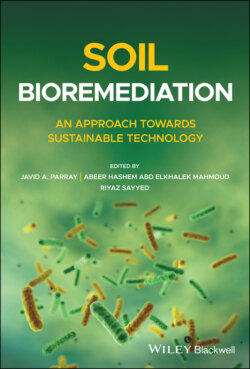Читать книгу Soil Bioremediation - Группа авторов - Страница 10
Preface
ОглавлениеThe economic growth and industrialization aimed at better living has resulted in environmental deterioration. The major contributing factors being industries, agriculture practices, and urbanizations, for example, that are a threat to the natural environment in all parts of the world. The fragile water and land ecosystems are under continuous threat due to the accumulation of toxic substances or contaminants thereby limiting the scope of sustainable development. Heavy metal pollution in soil is of particular concern, as it is accumulating further at higher trophic levels. The rigorous use of antibiotics, pesticides, herbicides, drugs, and other chemical forms with their persistence and disposal in a concentrated environment is also of great concern. The environmental self‐perpetuating process for transformation and degradation of xenobiotic substances is one of the key processes in natural systems. However, the rate of degradation may be reduced with the rise in pollutant concentrations. A major challenge in the current scenario is to improve the quality of the environment through effective utilization and conservation of natural resources, waste minimization, and adoption of the 3Rs, that is, reduce, recycle, and reuse. Besides, an increased demand for the remediation of wastes and contaminated areas has produced a new demand for improved and newer remediation methods that are appropriate at low cost and offer a broader application of waste management. Therefore, research into biological approaches for waste degradation has received great attention with bioremediation being one of the most important new innovations for the treatment of contaminated sites. Bioremediation mainly concerns the use of microbes and microbial agents to improve the quality of pollutant discharge in the environment vis a vis remediating contaminated sites. This book discusses effective and sustainable technological approaches for remediation of contaminates via ecofriendly usage of microbes and their products in all physical components of the environment. The main focus is the role of microbes, particularly bacteria and fungi, for degradation and removal of various xenobiotic substances from the environment. The book also emphasizes molecular approaches and the biosynthetic pathways of microbes and their gene and protein expression studies for biodeterioration techniques. As previously noted, increased urbanization and industrialization has a detrimental impact on a fragile environment and with this in mind some chapters focus on the role of biotechnological advances in cleaning the environment, through waste minimization and control, using new innovative and sophisticated green technologies. The book offers environmentalists and researchers new insights and directions in addition to motivations for waste management and control leading to effective conservation of natural resources. The research and their mechanisms presented here will be a major contributing factor to sustainable development. Presently, there is keen interest in environmental research particularly in pollution remediation, adoption of ecofriendly technologies, and the better use of agricultural products/residues as economical substrates for cleaning the environment. The untouched wealth of microorganisms in harsh environments are considered potential candidates for utilization in a better and sustainable future. A major part of this book highlights the potential aspects of microbes for various techniques of bioremediation, for example, biosorption, bioaugmentation, and biostimulation in cleaning a contaminated environment. This book covers established and up‐to‐date research on emerging trends in bioremediation and there are contributions from experimental and numerical researchers; reports on field trials are of special interest.
Javid A. Parray
